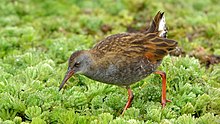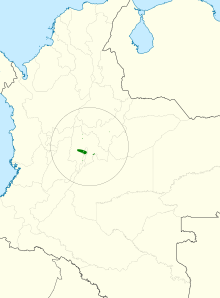
The Virginia rail is a small waterbird, of the family Rallidae. These birds remain fairly common despite continuing loss of habitat, but are secretive by nature and more often heard than seen. They are also considered a game species in some provinces and states, though rarely hunted. The Ecuadorian rail is often considered a subspecies, but some taxonomic authorities consider it distinct.

The water rail is a bird of the rail family which breeds in well-vegetated wetlands across Europe, Asia and North Africa. Northern and eastern populations are migratory, but this species is a permanent resident in the warmer parts of its breeding range. The adult is 23–28 cm (9–11 in) long, and, like other rails, has a body that is flattened laterally, allowing it easier passage through the reed beds it inhabits. It has mainly brown upperparts and blue-grey underparts, black barring on the flanks, long toes, a short tail and a long reddish bill. Immature birds are generally similar in appearance to the adults, but the blue-grey in the plumage is replaced by buff. The downy chicks are black, as with all rails. The former subspecies R. indicus, has distinctive markings and a call that is very different from the pig-like squeal of the western races, and is now usually split as a separate species, the brown-cheeked rail.

The clapper rail is a member of the rail family, Rallidae. The taxonomy for this species is confusing and still being determined. It is a large brown rail that is resident in wetlands along the Atlantic coasts of the eastern United States, eastern Mexico and some Caribbean islands. This species was formerly considered to be conspecific with the mangrove rail.

The black rail is a mouse-sized member of the rail family Rallidae that occurs in both North and South America.

Ridgway's rail is a near-threatened species of bird. It is found principally in California's San Francisco Bay to southern Baja California. A member of the rail family, Rallidae, it is a chicken-sized bird that rarely flies.

The African rail is a small wetland bird of the rail family that is found in eastern and southern Africa.
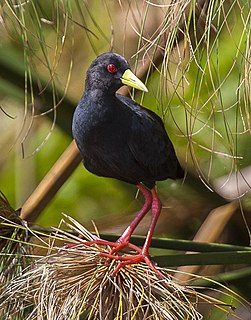
The black crake is a waterbird in the rail and crake family, Rallidae. It breeds in most of sub-Saharan Africa except in very arid areas. It undertakes some seasonal movements in those parts of its range which are subject to drought. No subspecies have been described. It appears that the oldest available name for this species is actually Rallus niger J. F. Gmelin, 1788, but Swainson believed that the earlier name was unidentifiable, and his own has since become well embedded in the literature.

The uniform crake is a species of bird in the subfamily Rallinae of the rail, crake, and coot family Rallidae. It is found in Mexico, most of Central America, and in nine South American countries.

The rufous-necked wood rail is a species of bird in the subfamily Rallinae of the rail, crake, and coot family Rallidae. It is found in Mexico, Central America, seven mainland South American countries, and Trinidad.
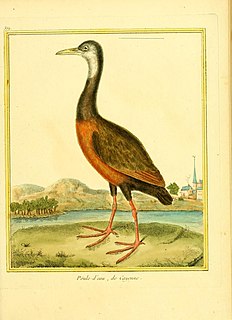
The brown wood rail is a Vulnerable species of bird in the subfamily Rallinae of the rail, crake, and coot family Rallidae. It is found in Colombia and Ecuador.
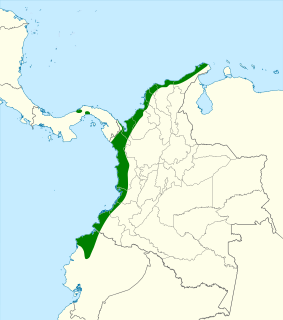
The Colombian crake is a species of bird in the subfamily Rallinae of the rail, crake, and coot family Rallidae. It is found in Colombia, Ecuador, and Panama.

The paint-billed crake is a species of bird in the subfamily Rallinae of the rail, crake, and coot family Rallidae. It is found in Costa Rica, Panama, every mainland South American country except Chile and Uruguay, and the Galápagos Islands.

The blackish rail is a species of bird in the subfamily Rallinae of the rail, crake, and coot family Rallidae. It is found in Argentina, Brazil, Colombia, Ecuador, Paraguay, Peru, Venezuela, and possibly Bolivia.

The plumbeous rail is a species of bird in the subfamily Rallinae of the rail, crake, and coot family Rallidae. It is found in Argentina, Bolivia, Brazil, Chile, Ecuador, Paraguay, Peru and Uruguay.

The spotless crake is a species of bird in the rail family, Rallidae. It is widely distributed species occurring from the Philippines, New Guinea and Australia, across the southern Pacific Ocean to the Marquesas Islands and south to New Zealand.

The austral rail is a Vulnerable species of bird in subfamily Rallinae of family Rallidae, the rails, gallinules, and coots. It is found in Argentina and Chile.

The plain-flanked rail is an Endangered species of bird in subfamily Rallinae of family Rallidae, the rails, gallinules, and coots. It is endemic to Venezuela.

The mangrove rail is a species of bird in subfamily Rallinae of family Rallidae, the rails, gallinules, and coots. It is found in Central and South America.

The Aztec rail or Mexican rail, is a Near Threatened species of bird in subfamily Rallinae of family Rallidae, the rails, gallinules, and coots. It is endemic to Mexico.

The Ecuadorian rail is a species of bird according to the International Ornithological Committee (IOC), but other taxonomic systems treat it as a subspecies of the Virginia rail. It is in subfamily Rallinae of family Rallidae, the rails, gallinules, and coots. It is found in Colombia, Ecuador, and Peru.
